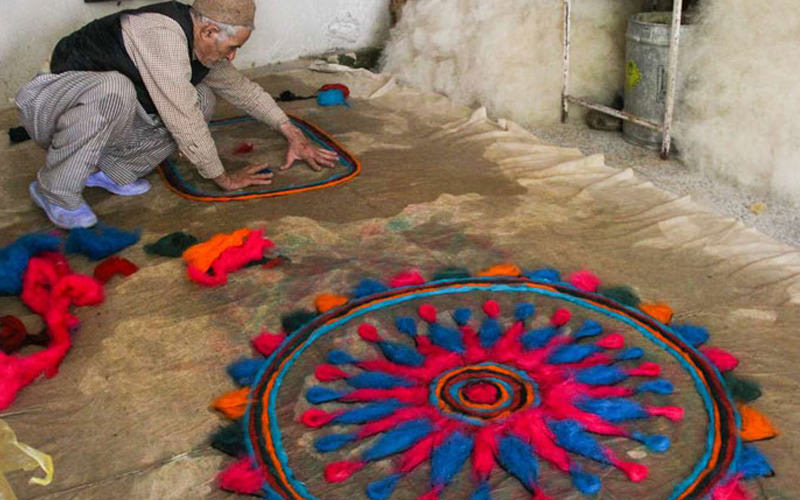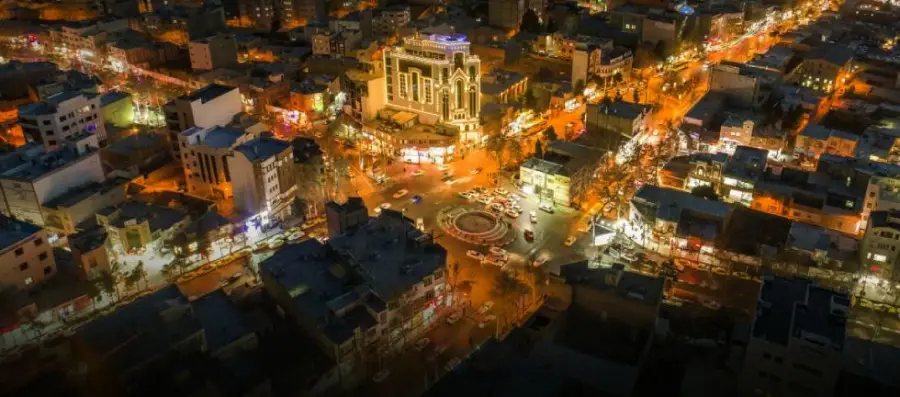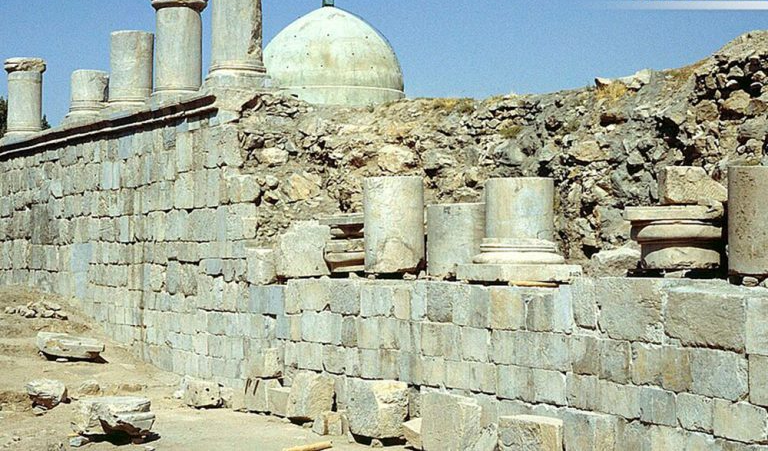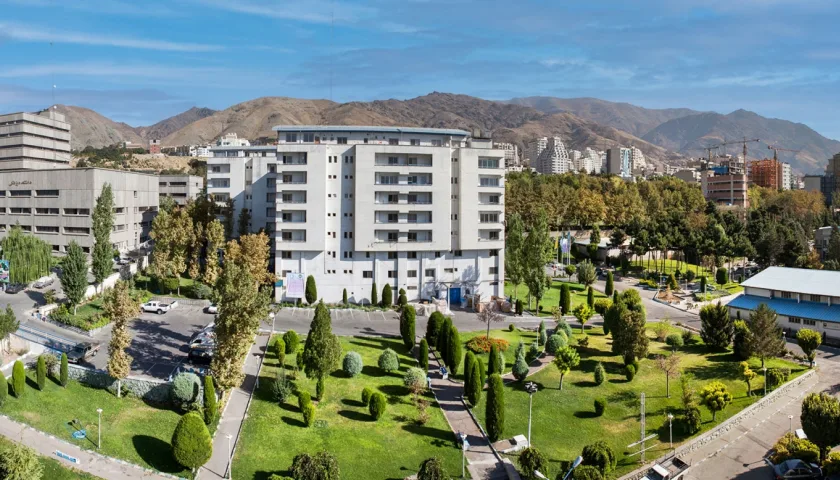Introducing all the tourist attractions of Shushtar : A Historical City in Khuzestan, Iran
Shushtar is a county in Khuzestan Province, Iran, and is considered to be the oldest city in the province. It is located in the north of the province and is known for its rich water resources. Shushtar has 13 UNESCO-registered World Heritage sites, making it a truly unique and historic city.
The name “Shushtar” is believed to mean “better” in Persian, and it is a fitting name for this beautiful city. Some people also call Shushtar “Shah Shater,” which is said to be derived from the word “Shusha” or “Susa.”
Shushtar has a pleasant climate in autumn and winter, but it can be very hot in summer. However, the city is still worth visiting, and it is best to plan your sightseeing for the early morning or late afternoon to avoid the heat.
Here are some of the things you can see and do in Shushtar:
Visit the Shushtar Historical Hydraulic System, a UNESCO World Heritage Site that is a complex of watermills, tunnels, and bridges.
Explore the ruins of the ancient city of Susa, which was once the capital of the Elamite Empire.
Relax in one of the many parks or gardens in Shushtar, such as the Amir Garden or the Kateh Museum Garden.
Take a boat ride on the Karun River, which flows through the city.
Sample the local cuisine, which includes dishes such as khoresh gheymeh (lamb stew with chickpeas and dried limes) and dolmeh (stuffed grape leaves).
Shushtar is a fascinating city with a rich history and culture. If you are ever in Iran, be sure to add Shushtar to your itinerary.
Shushtar: A Hidden Gem in Khuzestan, Iran
Nestled in the heart of Khuzestan province, Iran, lies the captivating city of Shushtar, a treasure trove of historical wonders and natural beauty. Situated approximately 95 kilometers north of the provincial capital, Shushtar beckons travelers with its rich heritage, enchanting landscapes, and warm hospitality.
Shushtar’s allure lies in its harmonious blend of ancient and modern elements. The city proudly bears the title of being one of the oldest continuously inhabited settlements in Iran, boasting a legacy that spans millennia. This rich history is evident in the city’s architectural marvels, such as the UNESCO-listed Shushtar Historical Hydraulic System, a testament to the ingenuity of past civilizations.
Beyond its historical significance, Shushtar captivates visitors with its breathtaking natural beauty. The Karun River, a majestic waterway, gracefully winds its way through the city, adding an element of tranquility to the vibrant urban landscape. Lush greenery adorns the surroundings, providing a refreshing escape from the bustling city center.
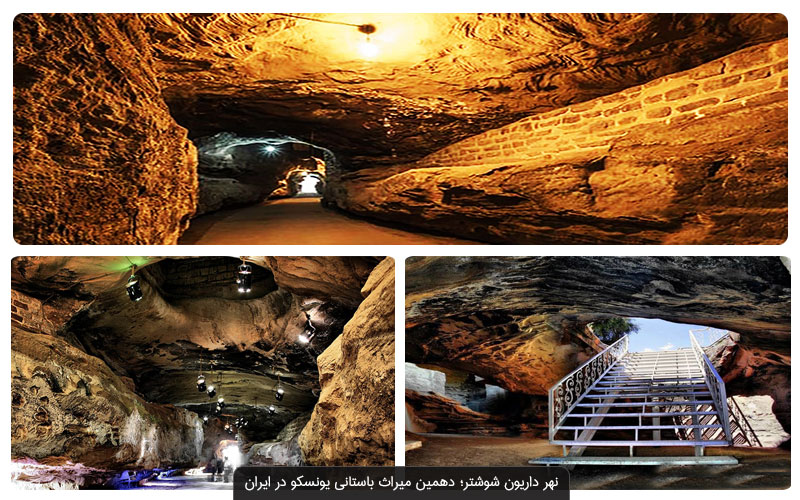
For those seeking cultural immersion, Shushtar offers a delightful array of experiences. Traditional bazaars brimming with local handicrafts and delectable treats entice visitors to explore the city’s vibrant commercial heart. The aroma of freshly brewed tea and the lively chatter of locals fill the air, creating an atmosphere of authentic Iranian charm.
Whether you’re drawn to its historical treasures, natural splendor, or cultural vibrancy, Shushtar promises an unforgettable experience. Embark on a journey through time as you wander through ancient ruins, immerse yourself in the beauty of nature’s embrace, and savor the flavors and traditions that define this captivating city. Let Shushtar weave its magic and create memories that will linger long after your departure.
Shushtar’s Historical Sights
Shushtar, a city steeped in history, boasts a captivating array of historical attractions that transport visitors to bygone eras. From ancient ruins to majestic structures, these landmarks offer a glimpse into the city’s rich past and architectural brilliance.
Kolah Farangi Tower: A Sentinel of Time
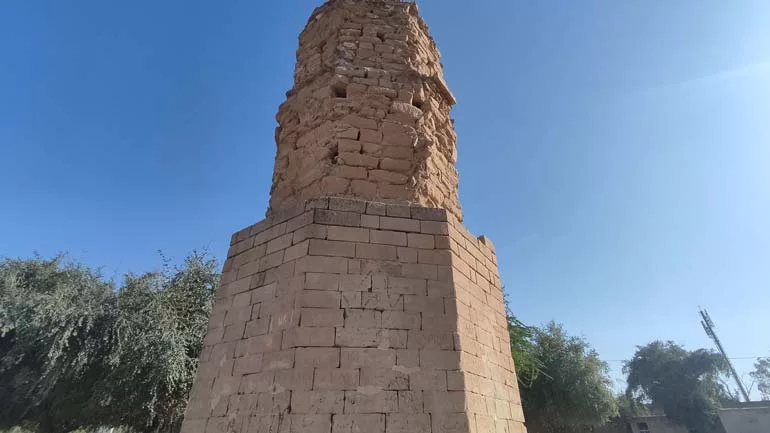
Standing as a silent sentinel, the Kolah Farangi Tower, also known as the Hat Tower, is an enigmatic structure shrouded in mystery. Its origins remain uncertain, with some experts attributing its construction to the Sassanian era, while others suggest a connection to Darius the Great’s Achaemenid Empire.
The tower’s octagonal shape and strategic location near the Karun River hint at its possible use as a watchtower, overseeing the river and monitoring the work of laborers. Another intriguing theory proposes its role as a communication tower during the Achaemenid period, employing fire signals to relay messages across vast distances.
In 2013, vandals inflicted damage upon the tower’s annexed shelter, prompting swift restoration efforts by the Cultural Heritage Base of Shushtar’s Historical Waterworks. Today, the Kolah Farangi Tower stands as a testament to Shushtar’s enduring legacy, inviting visitors to unravel its secrets and ponder its historical significance.
Location: Shushtar, 17 Shahrivar Square, end of Bolvar Street
Address: Shushtar, 17 Shahrivar Square, end of Bolvar Street
As you embark on your exploration of Shushtar’s historical gems, let these landmarks transport you through time, revealing the city’s captivating narrative and the enduring spirit of its people.
Shushtar’s Hydraulic Structures: Marvels of Engineering Ingenuity
Shushtar’s hydraulic structures stand as a testament to the extraordinary engineering prowess and water management expertise of the ancient world. These intricate marvels, dating back to the Sassanian era, showcase the ingenuity of bygone civilizations and their mastery of harnessing the power of water.
The hydraulic structures, a UNESCO World Heritage Site, epitomize the harmonious blend of functionality and aesthetic beauty. These structures not only facilitated efficient water distribution and irrigation but also served as architectural masterpieces, adorned with intricate carvings and arches that reflect the artistic sensibilities of the era.
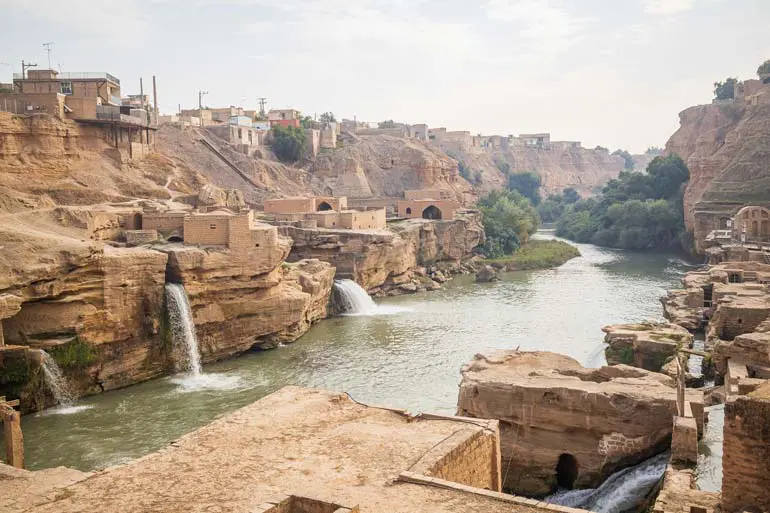
The construction of these structures is attributed to Sassanian kings such as Ardashir I and Shapur I, with further refinements made in subsequent periods. Evidence suggests that even during the Qajar era, these structures received ongoing maintenance and restoration.
Address: Shushtar, near 15 Khordad Square
As you explore these hydraulic wonders, marvel at the intricate details of the waterwheels, canals, and tunnels that once powered mills, regulated water flow, and irrigated surrounding lands. These structures serve as a tangible link to Shushtar’s rich history, offering a glimpse into the remarkable achievements of ancient engineers and their profound understanding of water management.
Band-e Khaak: A Majestic Dam in Shushtar’s Hydraulic System
Nestled near the revered Imamzadeh Abdullah shrine, Band-e Khaak stands as a testament to the engineering brilliance of Shushtar’s ancient hydraulic structures. This magnificent dam, constructed during the Sassanian era, played a crucial role in diverting water from the Dariyun Canal to the Raqqat Canal. Additionally, it served as a flood control mechanism, safeguarding the region from the potential inundation of the Rivan Canal.
Band-e Khaak’s enduring legacy is evident in its designation as a National Monument of Iran in 2004 and its subsequent inscription as a UNESCO World Heritage Site in 2009. These accolades underscore the dam’s exceptional historical and cultural significance.
Address: Khuzestan, Shushtar, Old Beltway, Northwest of Imamzadeh Abdullah
Historical houses of Shushtar
Mostofi House: A Glimpse into Qajar-Era Splendor
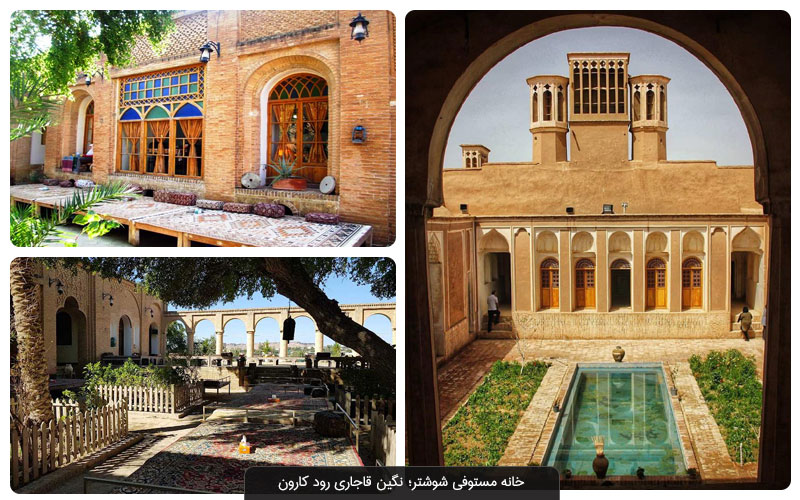
Gracing the heart of Shushtar’s historical district, Mostofi House beckons visitors with its captivating blend of architectural elegance and rich history. Originally the residence of a wealthy merchant named Mohammad Ali Mostofi, this grand structure now serves as a charming restaurant, photography studio, and museum, offering a delightful fusion of heritage and hospitality.
Dating back to the late Qajar era, Mostofi House showcases the architectural finesse of the time, characterized by intricate brickwork, graceful arches, and a harmonious blend of indoor and outdoor spaces. The verdant courtyard, adorned with a majestic tree providing ample shade, serves as a tranquil oasis amidst the bustling city.
From the courtyard’s meandering walkways, visitors are treated to breathtaking vistas of the Band-e Shadorvan Bridge and the Shatit River, further enhancing the house’s allure. The architectural brilliance of Mostofi House is attributed to the masterful craftsmanship of Haj Mohammad Taqi Memar, ensuring that every detail exudes elegance and sophistication.
A highlight of the house’s eastern section is an octagonal pool with a smaller circular pool at its center, adding a touch of tranquility and visual appeal.
Address: Khuzestan, Shushtar, Battani Square, Next to Mostofi Mosque
As you explore these two captivating landmarks, let them transport you through the annals of Shushtar’s rich history, revealing the ingenuity, artistry, and cultural heritage that have shaped this remarkable city.
Afzali Caravanserai: A Qajar-Era Architectural Gem

Step back in time and immerse yourself in the grandeur of the Afzali Caravanserai, a remarkable Qajar-era structure that stands as a testament to the architectural prowess of the era. This four-story caravanserai, comprising a sublevel, ground floor, first floor, and shoodan (upper level), showcases intricate brickwork patterns, including chevron, basket weave, and straight designs.
Admire the exquisite brickwork adorning the courtyard’s perimeter platform, crafted in the Fakhromadin style, characterized by a repetitive network of bricks. The name “Fakhromadin” derives from the words “fakh” (baked clay) and “madin” (female, depression, or hole), alluding to the interlocking brick pattern.
The courtyard’s flooring features a captivating pattern of brick frames, adding to the caravanserai’s aesthetic allure. Today, this magnificent structure serves as a permanent venue for showcasing the region’s rich handicraft traditions.
Address: Khuzestan, Shushtar, Taleghani Street, Sangfarsh Alley
Marashi House: A Fusion of Qajar and Pahlavi Architectural Styles
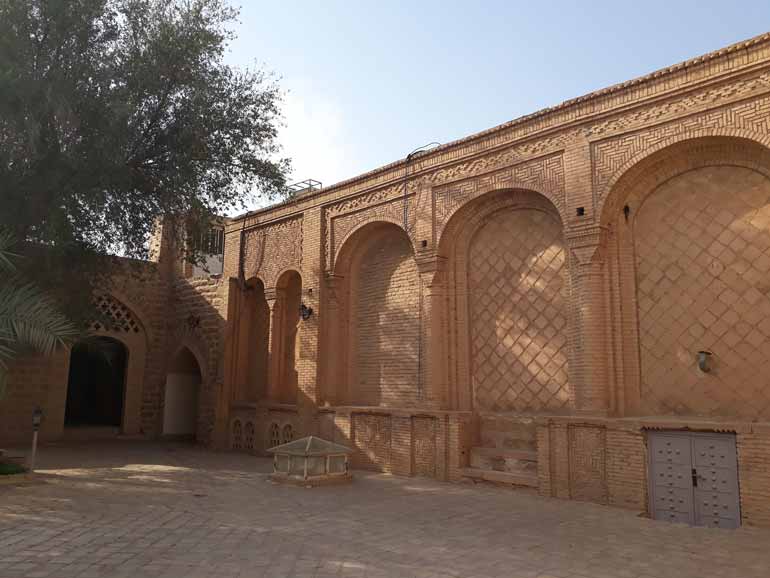
Amidst the labyrinthine alleyways of Shushtar’s old town, the Marashi House emerges as a captivating blend of Qajar and Pahlavi architectural styles. Originally the residence of Seyyed Mohammad Hossein Marashi and his family, this historic structure now serves as the headquarters for the Shushtar Hydraulic Structures World Heritage Site Base.
Perched atop a towering cliff overlooking the river and the mesmerizing Shushtar Hydraulic Structures, the Marashi House offers breathtaking views of cascading waterfalls and ancient mills. Imagine the tranquility and splendor that must have enveloped the Marashi family as they resided in this extraordinary abode.
Address: Khuzestan, Shushtar, Imam Street, Western Gate of Shushtar Waterfalls
Aminzadeh House: A Qajar-Era Architectural Masterpiece
Step into the grandeur of the Qajar era with the Aminzadeh House, a remarkable structure that stands as a testament to the exquisite craftsmanship and artistic sensibilities of the time. Built by a prominent figure named Aminzadeh, this historic building has become one of the most celebrated landmarks in Shushtar’s old town.
The Aminzadeh House is distinguished by its captivating ornamentation, evident in the intricate stonework, brickwork, rock carvings, and delicate lattice plasterwork adorning various sections, particularly the facades of the iwans (arched porches).
As you approach the entrance, admire the mesmerizing beauty of the ornate brick columns that flank the doorways. Inside, the house unveils a treasure trove of decorative elements that defy mere description, leaving you awestruck by the artistic mastery on display.
The Aminzadeh House, recognized for its exceptional historical and architectural significance, was inscribed on the National Register of Iran in 1999.
Address: Khuzestan, Shushtar, Kandall Neighborhood, Aminzadeh Alley
Gazer House: A Qajar-Era Mansion Steeped in History

Journey through the annals of Shushtar’s rich history at the Gazer House, a captivating Qajar-era mansion that bears the indelible marks of time. Experts consider this structure to be the second most significant historical building in Shushtar, a testament to its architectural grandeur and historical value.
Originally a residential abode within the Afzali Complex, the Gazer House eventually passed into the ownership of an individual named Gazer, giving rise to its current name.
The mansion’s architectural elements include a central courtyard, iwans, a sublevel (shabestan), and numerous rooms. The decorative highlights of the Gazer House lie in its exquisite brickwork, stone carvings, and intricate lattice plasterwork.
To optimize natural daylight, the architects ingeniously incorporated skylights into the facades of archways, the main entrance, and the surfaces of the iwans.
Address: Khuzestan, Shushtar, Imam Khomeini Square, Seyyed Ali Akbar Ahmadzadeh Jazayeri Alley
Zoroastrian Necropolis of Shushtar: A Glimpse into Pre-Islamic Traditions

Venture into the heart of the Zoroastrian faith by exploring the Zoroastrian Necropolis of Shushtar, also known as the “Kharfeh Khaneh of Shushtar” or “Stoodans of Shushtar.” These remarkable structures, carved into the rocky cliffs north of Shushtar, offer a fascinating glimpse into pre-Islamic funerary practices.
To fully appreciate the historical significance of Shushtar, a visit to the Zoroastrian Necropolis is essential. These ancient structures, dating back to pre-Islamic times, were used for the interment of the deceased, with their origins likely traced to the Parthian and Median eras.
The Zoroastrian Necropolis of Shushtar is conveniently situated on the lower slopes of the cliffs, making them easily accessible to visitors.
Address: Khuzestan, Shushtar, North of the City
Chahar Taqi of Shushtar: A Sentinel of Zoroastrian Heritage

Nestled along the banks of the Gargar River, the Chahar Taqi of Shushtar stands as a silent sentinel of Shushtar’s rich Zoroastrian heritage. This ancient structure, characterized by its domed roof supported by four pillars, once served as a sacred fire temple for Zoroastrian devotees.
Dating back to pre-Islamic times, the Chahar Taqi holds immense historical significance. Its architectural design, with its arched entrances on each side and access via a set of timeworn earthen steps, reflects the Zoroastrian reverence for fire as a symbol of purity and divinity.
During the Qajar era, the Chahar Taqi underwent a functional transformation, serving as a prayer hall and mosque for the mill workers residing in the vicinity. This adaptation highlights the enduring legacy of the structure, seamlessly transitioning from a Zoroastrian sacred site to a place of worship for a different faith.
Address: Khuzestan, Shushtar, Gargar Riverbank
To Ashaghun of Shushtar: A Cave of Solitude and Devotion
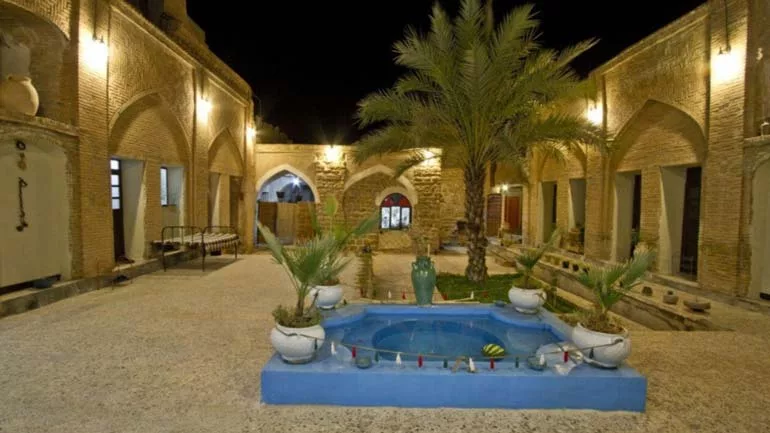
Carved into a rocky hill adjacent to the Imamzadeh Abdullah Shrine, the To Ashaghun of Shushtar offers a glimpse into the spiritual practices of bygone eras. This historic chamber, dating back to the Seljuk period, served as a retreat for ascetics and a place for spiritual seclusion.
Within the To Ashaghun, visitors can admire a stone crescent and a stone niche, remnants of the chamber’s original purpose. The name “To Ashaghun” itself is derived from the words “to” meaning “room” and “ashag” meaning “lovers,” alluding to the chamber’s association with spiritual devotion and solitude.
Address: Khuzestan, Shushtar, Taleghani Street, Adjacent to Imamzadeh Abdullah Shrine
Famous Bridges of Shushtar
Shushtar’s abundance of water has necessitated the construction of numerous bridges and dams throughout the city. Here’s an introduction to some of these remarkable structures:
Band-e Lashkar Bridge:
Purpose: Connect Shushtar to nearby settlements and regulate water flow
Construction Period: Original structure dates back to ancient times; Safavid-era arches added later
Dimensions: 124 meters long, 8 meters high
Materials: Sand, mortar, and stone
Current State: 11 of its original 13 arches remain; 5 were destroyed in the Qajar era and not repaired due to high costs
Shādorvān Bridge (Band-e Kaisar):
Also known as Valerian Bridge and Band-e Kaisar
Construction Period: Sassanian era
Architect: Roman engineer Branus
Location: Near Band-e Mizan
Dimensions: 500 meters long, spanning the Karun River
Original Structure: 44 large arches and 43 smaller arches
Current State: Ruins remain, with most of the bridge sections over the Karun River destroyed
Purpose: Water supply to Shushtar
Construction Order: Shapur I
Legend: The soil for the bridge’s construction was brought from Rome to Shushtar by Valerian on Shapur’s orders, as the local soil was unsuitable.
Address:Band-e Lashkar Bridge: Khuzestan, Shushtar, Shahid Square, next to Imamzadeh Abdullah Shrine
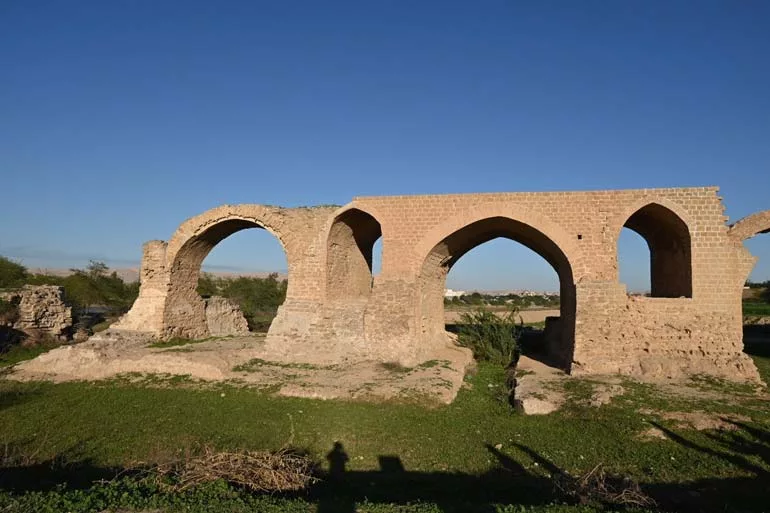
Shādorvān Bridge (Band-e Kaisar): Khuzestan, Shushtar County, 300 meters south of Band-e Mizan
As you explore these bridges, imagine the bustling past of Shushtar, where these structures played a vital role in connecting communities, regulating water, and showcasing the city’s architectural prowess.
Shushtar’s Majestic Citadels and Serene Gardens
Shushtar, with its warm, sunny climate, beckons visitors seeking respite from the sun’s embrace. Here’s an introduction to some of the ancient citadels and tranquil gardens that dot the city:
Salasel Citadel:
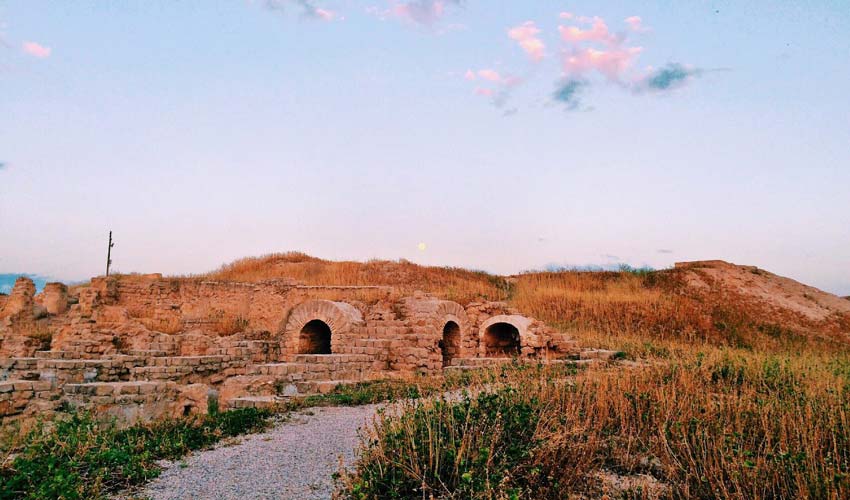
UNESCO World Heritage Site
Dates back to the Achaemenid era
Once a vast complex with multiple courtyards
Distinguished by its turquoise, gold, and lapis lazuli adornments and magnificent kiosks
Served dual purposes: overseeing water distribution and holding strategic, governmental, and military significance
Grandeur eroded over time due to weathering, yet remnants still exude strength and beauty
Southeast gate once featured a grand wooden door (now vanished)
Registered as a National Monument of Iran on June 25, 2009
Inscribed as part of the Shushtar Hydraulic System on the UNESCO World Heritage List on June 26, 2009
Address: Khuzestan, Shushtar, Karun Riverbank, near Mostofi Mosque and Azadigan Bridge
Rostam Aghili Citadel:
Ruins of a bygone era
Located opposite the citadel, on the left bank of the river, atop a hill
Locals refer to it as “Rostam”
Legends associate the site with a battle between the one-handed Rostam and Rostam Zal
Served as a prison during peaceful times and a refuge during periods of unrest
Khan Garden:

Dates back to the Qajar era
Situated on the western bank of the Gargar River
Watered by canals from the city’s waterfalls and mills
Epitomizes traditional Qajar architecture
Lush with fruit trees interspersed with ornamental shrubs and flowers (shahpasand, abbas tulips, roses, mohammadi, bougainvillea)
Address: Khuzestan, Shushtar, End of Imam Sharqi Street, Bibi Dokhtaran Neighborhood
Shushtar’s Springs, Rivers, and Canals: A Haven of Tranquility
Amidst the arid landscapes of Khuzestan, Shushtar emerges as an oasis of refreshing springs, meandering rivers, and ancient canals. These natural wonders offer a respite from the city’s warmth, inviting visitors to immerse themselves in the serenity they exude.
Sūzangar Spring:
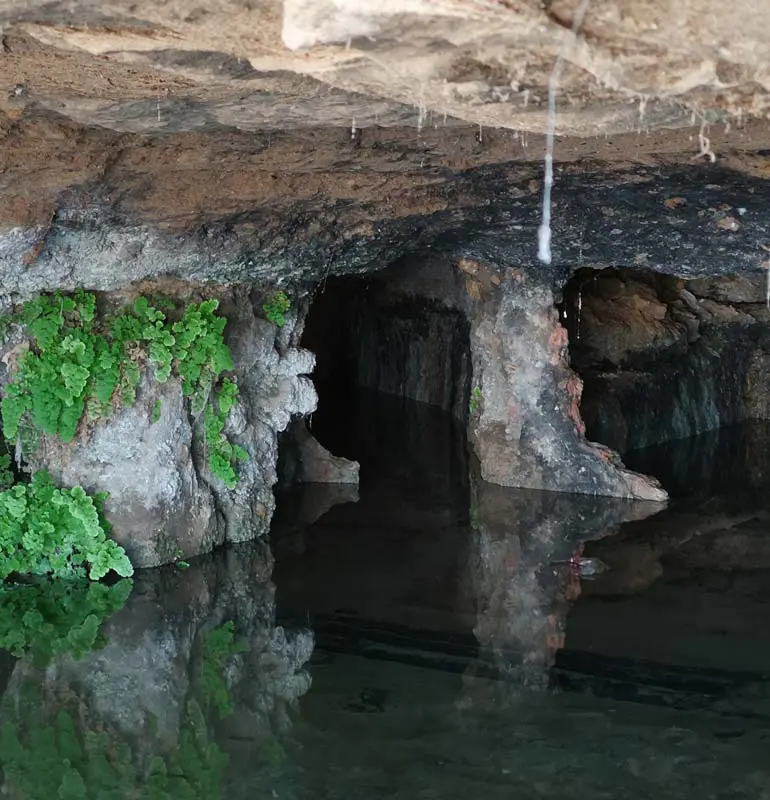
Nestled in the northwestern corner of Saheb-al-Zaman Promenade
Revered as a sacred site by the people of Shushtar
Associated with the life of Seyyed Sahel ben Abdallah Shushtari, a revered Sufi mystic of the 3rd century AH
Believed to have been a place of worship and cultivation for the mystic
Characterized by a rocky archway, a large rectangular stone opening, and a basin from which the spring water flows
An ancient Konar tree stands beside the spring, adding to its picturesque charm
A chamber carved into the rock face near the spring, known as “Tokamari,” is said to house the mystic’s tomb
Locally referred to as “Sizangar” due to its association with the word “sezn” meaning “needle” in the local dialect
Address: Khuzestan, Shushtar, Northwest of Saheb-al-Zaman Promenade
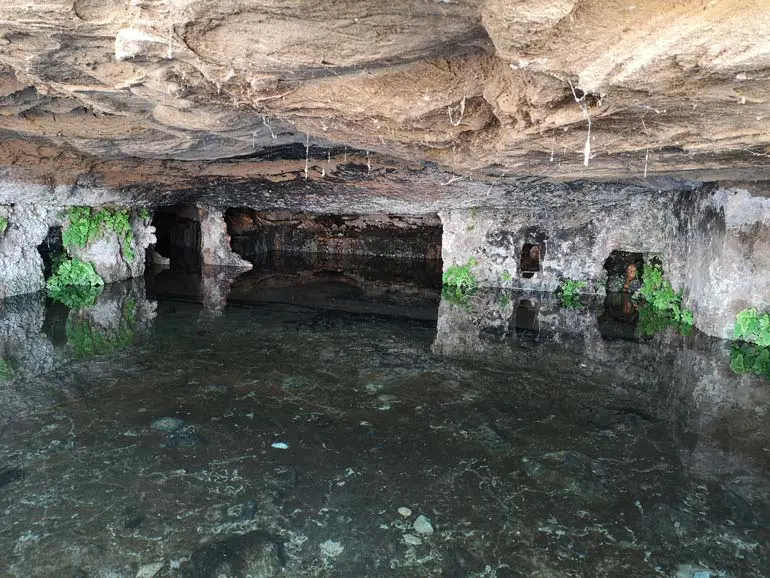
Dariun Canal and Hand-Dug Gargar River:
Dariun Canal, a testament to the ingenuity of the Achaemenid era
Diverted from the Shatit River in Shushtar, it rejoins the river after its course
Headwater of the canal lies beneath the Salasel Citadel, where it was once regulated by mirabs (water distributors) from within the citadel
Named after Darius the Great, the Achaemenid king, it also bears the alternate names “Dara” and “Darius”
Recognized as a UNESCO World Heritage Site in 2009
As you explore these natural wonders, let the gentle murmur of flowing water and the cool embrace of the shade transport you to a realm of tranquility, where the spirit of Shushtar’s rich history and deep connection to water comes alive.
Shushtar’s Majestic Dams: Engineering Marvels of the Past
Shushtar, renowned for its intricate hydraulic system, boasts a collection of awe-inspiring dams that stand as testaments to the engineering prowess of bygone eras. These marvels of construction not only regulated the flow of water but also played a pivotal role in shaping the city’s landscape and economy.
Band-e Dokhtar (Daughter Dam):

Nestled 3 kilometers north of Shushtar, where the Karun River emerges from the mountains into the plains
Strategically positioned at the river’s narrowest point
Construction attributed to the Sassanian era
Named “Daughter” due to its proximity to the “Dohtar Castle”
Band-e Sharabdar (Winebearer Dam):
Graces the Dariun Canal
Etymology: “Sharabdar” (winebearer) derived from its role in irrigating vineyards along its course
Dates back to the Sassanian era
Constructed from stone, featuring two curves on its eastern and western sides
Address: Khuzestan, South of Shushtar, between Band-e Khodafarin and Band-e Lashkar
Band-e Mizan (Balance Dam):
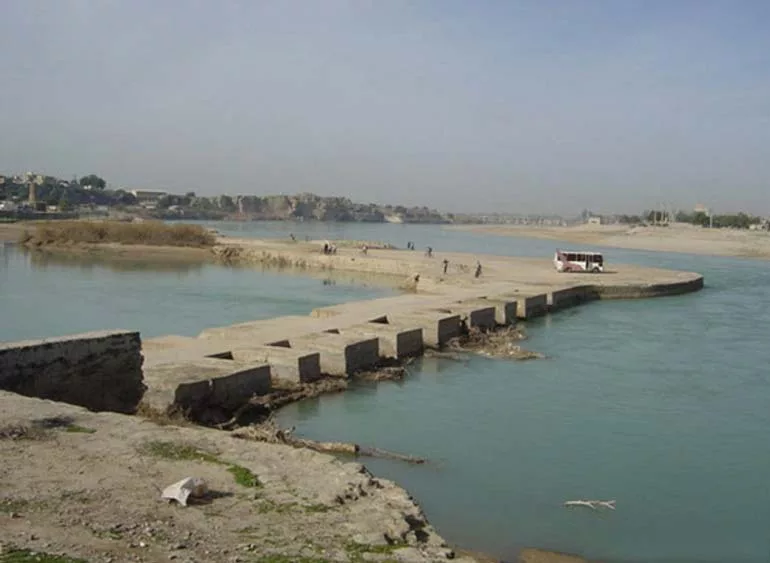
A picturesque water structure spanning the Karun River
Situated north of Shushtar, south of the Seyyed Mohammad Giyahovar Shrine
Construction initiated during the Achaemenid period, completed during the Sassanian era
Purpose: Water management and distribution
Etymology: “Mizan” (balance) reflects its role in regulating water flow to prevent excessive strain on Shushtar’s hydraulic structures, particularly the mills
Precision-engineered to ensure equitable water distribution among canals and channels
Constructed using a combination of Saruj mortar and hewn sandstone blocks
Slanting structure measuring 390 meters in length and 4.5 meters in height
Divides the Karun River’s water into two proportions: 2:4
Crucial component in creating the hydraulic ring of Shushtar’s waterworks
Address: Khuzestan, Shushtar County, End of Sharaf Boulevard
Shushtar’s Bustling Bazaars: A Glimpse into Local Life
Shushtar, like many ancient Iranian cities, pulsates with the vibrant energy of its traditional bazaars, where the cacophony of vendors and shoppers fills the air. Here, we delve into two of the city’s most prominent marketplaces:
Shushtar Traditional Bazaar:
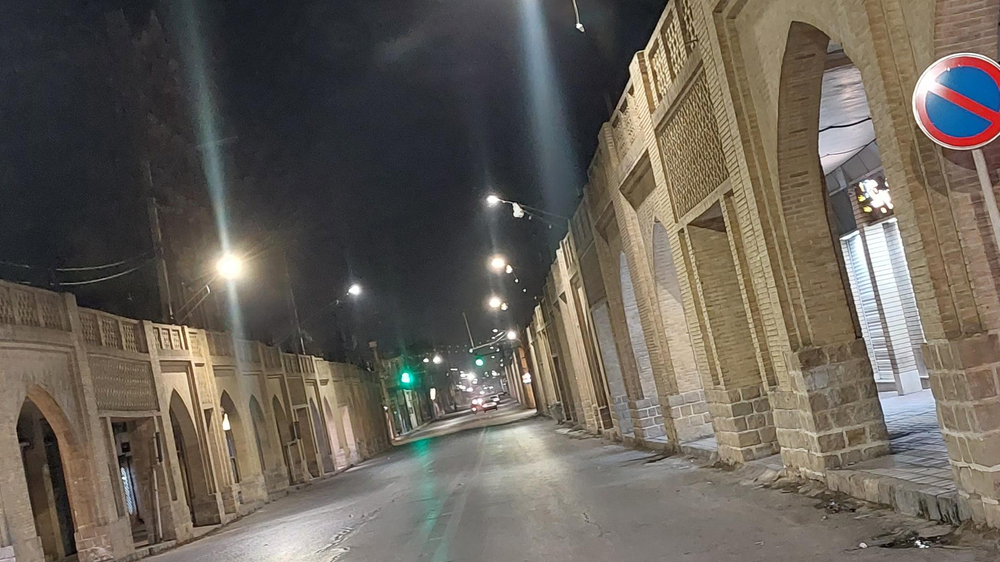
Established during the Qajar era, serving as the commercial heart of Shushtar
Preserving its old-world charm, with a labyrinthine layout and dimly lit ambiance
Characterized by a cruciform structure with covered sections housing an array of shops
A treasure trove of goods, from everyday necessities to local handicrafts
The rhythmic cries of porters carrying goods blend harmoniously with the lively chatter of shoppers
Address: Khuzestan, Shushtar, Imam Khomeini Square, Taleghani Square
Mehestan Passage:
A modern shopping center located on Imam Khomeini Street
A haven for those seeking contemporary shopping experiences
A hub for traditional Khuzestani attire, offering a delightful array of local garments
Address: Khuzestan, Shushtar, Imam Khomeini Street, Opposite Ebrishmgaran Mosque
Shushtar’s Serene Parks: A Haven of Tranquility
Amidst the historical allure of Shushtar, verdant parks emerge as tranquil oases, offering respite from the city’s vibrant energy. Here, we unveil three of Shushtar’s most cherished green spaces:
Dariun Park:
Nestled atop the Dariun Canal, at the intersection of Shatit Bridge and Sheikh Shushtari Boulevard
Boasts a serene waterfront section, ideal for moments of peaceful reflection
Adorned with a captivating rainbow-hued fountain, adding a touch of vibrancy to the park’s ambiance
Address: Khuzestan, Shushtar, Dariun Park Road
Hormoz Park:
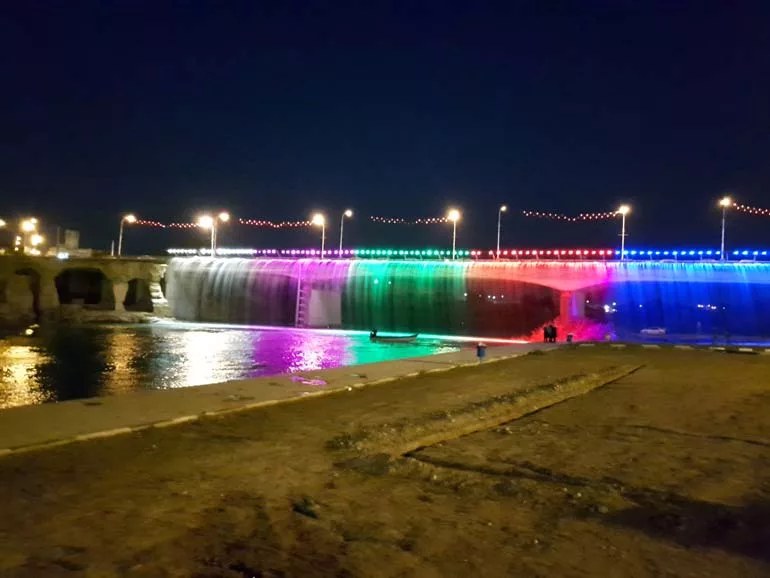
Gracing the landscape above Dariun Park, sprawling across an expansive area
Enjoys a waterfront along the Karun River, providing a picturesque backdrop for relaxation
Characterized by its towering, ancient trees, offering a welcome respite from the sun’s embrace
Indulge in the gentle breeze wafting from the Karun River, rustling through the leaves
Address: Khuzestan, Shushtar, After Dariun Park
Jazireh Park:
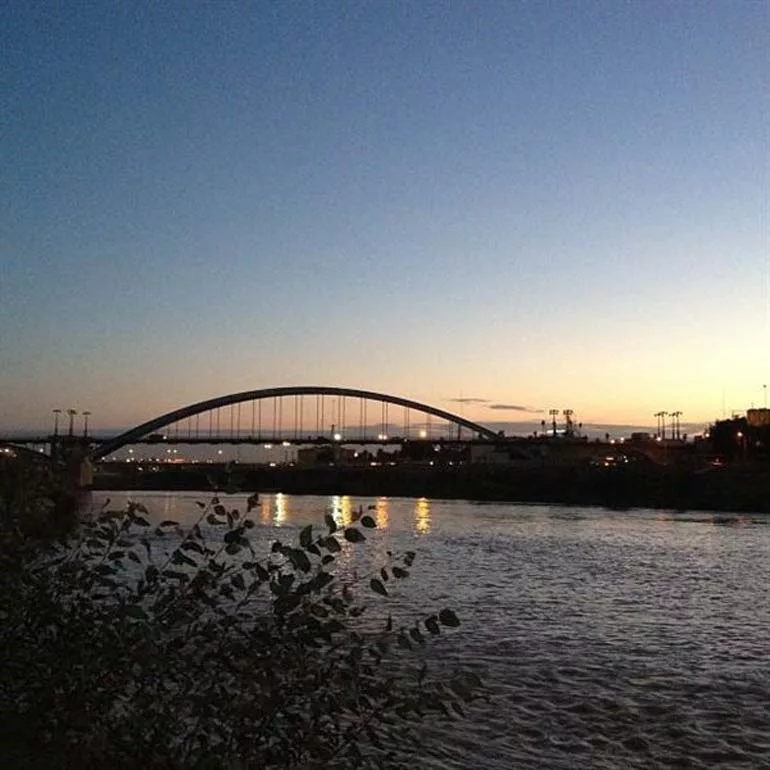
Shushtar’s bustling hub during the summer months, teeming with life and activity
Strategically situated at the confluence of the Karun River, where the river splits and rejoins
Easy access to the Karun River from both sides makes it a top choice for families seeking weekend getaways
Rent a boat and embark on a delightful journey along the mighty Karun River
Address: Khuzestan, Shushtar, Shatit Bridge
Shushtar’s Spiritual Haven: Mosques and Religious Sites
Shushtar’s rich history intertwines with its spiritual heritage, evident in the city’s numerous mosques and religious landmarks. These architectural gems showcase diverse styles, adorned with intricate tilework and brickwork, inviting visitors to delve into the city’s spiritual essence.
Jameh Mosque of Shushtar:
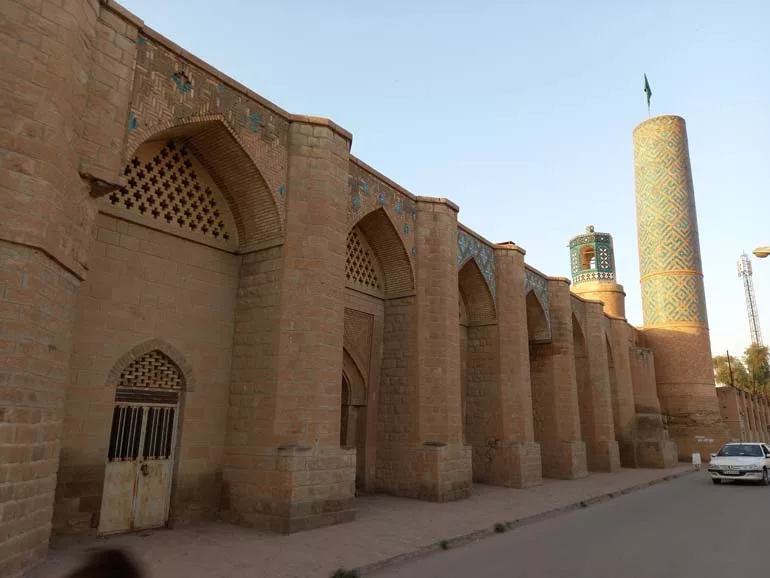
Standing tall for over 12 centuries, the Jameh Mosque of Shushtar ranks among Iran’s oldest congregational mosques, rivaled only by Yazd’s Jameh Mosque.
Debates surround its exact age, with some attributing its construction to the Sassanian era based on its lofty Iwan, arched vaults, and prayer hall.
The mosque’s structure, primarily constructed from brick, features a mesmerizing turquoise-hued minaret adorned with exquisite tilework.
Historical evidence suggests the original mosque comprised a Qibla-oriented prayer hall, flanked by porticoes and a courtyard, reflecting Arabian architectural style.
During the Safavid era in 1088 AH, the mosque’s wooden beams succumbed to damage but were promptly replaced.
Subsequent renovations have shaped the mosque’s current appearance, aligning more closely with Safavid architectural sensibilities.
Remnants of the original structure include inscriptions, sections of the Qibla-oriented wall, the minaret, and the eastern wall between the minaret and minaret lantern.
Address: Khuzestan, Shushtar, Jameh Mosque Street
Shrine of Seyyed Mohammad Golābi (Seyyed Mohammad Giyāhkhor Shrine):
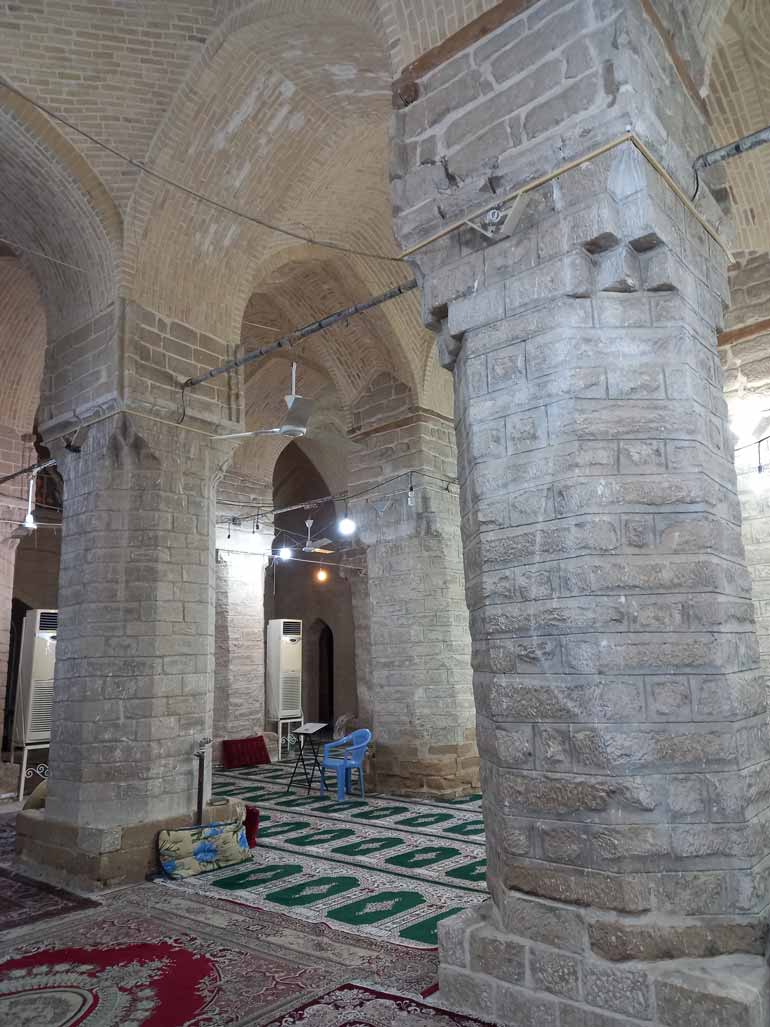
Revered as the resting place of Seyyed Mohammad Golābi, a descendant of Imam Musa al-Kazim (AS), the Shrine of Seyyed Mohammad Golābi, also known as Seyyed Mohammad Giyāhkhor Shrine, stands as a prominent religious landmark.
Situated on Saheb-al-Zaman Street, the shrine draws pilgrims and visitors seeking spiritual solace.
Dating back to the Safavid era, the shrine boasts a distinguished history spanning approximately 250 years.
Renovations during the Qajar era further enhanced the shrine’s grandeur.
The shrine features a tall, slender dome and offers breathtaking views of the Karun River from its southern and western sides.
The shrine’s northern side overlooks the Shrine of Sheikh Allameh Shushtari.
Address: Khuzestan, Shushtar, Saheb-al-Zaman Street
Shrine of Saint George:
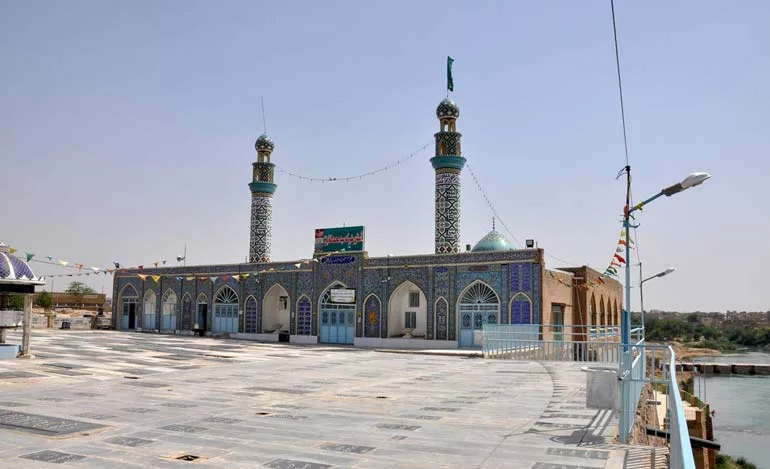
Nestled in the village of Jurgis, southwest of Shushtar, the Shrine of Saint George holds a special place in the hearts of many.
While some believe the shrine marks the burial site of Saint George, the prophet, others question this claim.
The true resting place of Saint George is likely to be in Mosul, Iraq.
Alternatively, the remains interred within the shrine could belong to another prophet named George.
Address: Khuzestan, Shushtar, Jurgis Village
Saheb-al-Zaman Promenade:
The azure dome of Saheb-al-Zaman Promenade, harmonizing with the cerulean sky, beckons pilgrims and visitors alike.
Also known as Bocheh Saheb-al-Zaman, the promenade stands adjacent to the Shrine of Sheikh Shams al-Din Shushtari.
Perched atop a hill amidst a cemetery, the promenade exudes an air of serenity.
A recently discovered inscription within one of the promenade’s dilapidated chambers reveals its construction in 1407 AH during the reign of Shah Safi Safavid by a man named Dervish Karim.
Further embellishments were added to Saheb-al-Zaman Promenade in the early 14th century AH by Haj Mullah Hussein Tabibi Shushtari.
The promenade serves as a burial ground for many revered figures and scholars throughout history.
Among the promenade’s captivating adornments are exquisite carvings, woodwork, tilework, and calligraphic inscriptions.
Address: Khuzestan, Shushtar, End of Beinolharam Expressway
Imamzadeh Abdullah of Shushtar:
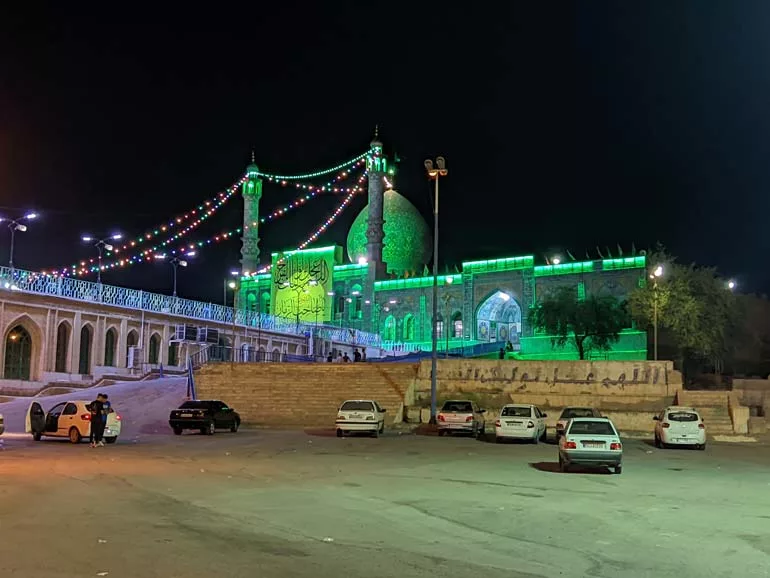
Gracing the southern outskirts of Shushtar, Imamzadeh Abdullah stands as a revered shrine, offering panoramic views from its hilltop perch.
This sacred site enshrines Imamzadeh Abdullah, a descendant of Imam Zayn al-Abidin.
The initial structure and tomb were constructed during the Seljuk era, while the cenotaph was added during the Qajar period.
Inspired by Safavid architectural principles, the cenotaph features a conical dome with gradually diminishing bricks towards the apex.
The shrine’s structure is primarily brick, while its minaret is adorned with intricate tilework.
Address: Khuzestan, South
Unforgettable Shushtar: A Traveler’s Guide
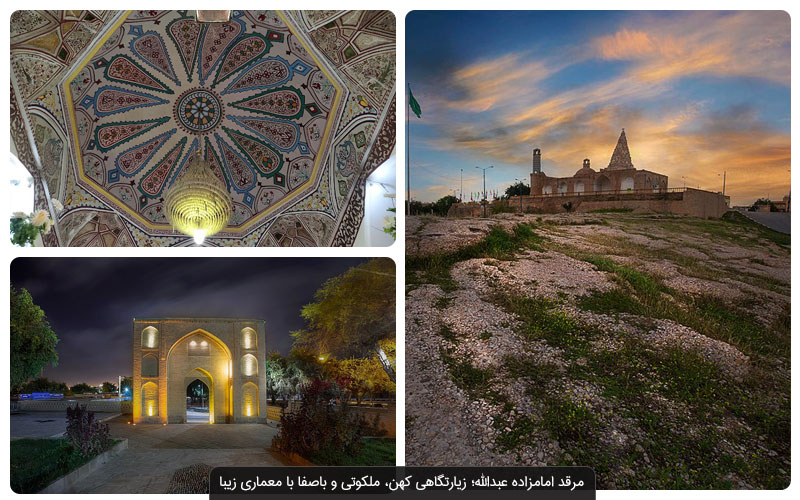
Shushtar, a city steeped in history and natural splendor, awaits your exploration. To fully immerse yourself in its captivating charm, consider these recommendations:
Transportation:
For a swift and convenient journey, consider air travel. The extended distance from major cities necessitates careful planning.
Accommodation:
Embrace the spirit of adventure by camping in Shushtar’s renowned parks, immersing yourself in the city’s vibrant atmosphere.
Alternatively, opt for hotel accommodations to ensure a comfortable and hassle-free stay.
Essential Gear:
Stay connected with your smartphone and power bank, ensuring you can capture precious memories and navigate with ease.
Dress appropriately for the season. During the summer months, light, airy clothing in white shades will keep you cool. For winter visits, pack a lightweight jacket for warmth.
Preserving Heritage:
Shushtar’s intricate hydraulic structures stand as testaments to the city’s engineering prowess. Treat these marvels with respect and care, ensuring their preservation for generations to come.
Inspiring Generations:
Share the wonders of Shushtar with your loved ones, creating memories that will last a lifetime. Let the city’s rich heritage and natural beauty captivate the minds and hearts of future generations.
Exploring Shushtar’s Treasures:
Shushtar boasts over 100 hydraulic structures, a testament to its mastery of water management. Despite its location in southwestern Iran, the city’s abundance of water resources has shaped its unique identity.
Karun River’s Embrace:
The mighty Karun River, gracefully flowing through Shushtar, paints a picturesque landscape. Its refreshing waters and the surrounding historical structures create an unforgettable ambiance.
Marvels of Hydraulic Engineering:
Shushtar’s hydraulic structures stand as its crown jewels, captivating visitors with their ingenious design, intricate engineering, and architectural elegance. These marvels of the past serve as a reminder of human ingenuity and harmony with nature.
A Journey Through Time:
As you delve into Shushtar’s rich history and explore its captivating attractions, let the city’s timeless beauty transport you to a realm where innovation, engineering brilliance, and natural splendor intertwine, creating an unforgettable travel experience.

Frequently Asked Questions about Shushtar
1. What are Shushtar’s most renowned attractions?
Shushtar, a city steeped in ancient history, is famed for its awe-inspiring hydraulic structures, including:
Band-e Kaisar (Kaiser Dam): A majestic dam dating back to the Sassanian era, showcasing remarkable engineering prowess.
Sازه های آبی شوشتر (Shushtar Waterworks): A UNESCO World Heritage Site, comprising a remarkable network of canals, tunnels, and waterwheels that epitomize ancient hydraulic engineering.
قلعه سلاسل (Salasel Castle): A formidable fortress perched atop a hill, offering panoramic views of the city and the Karun River.
پل بند میزان (Band-e Mizan Bridge): A marvel of Sassanian engineering, regulating water flow and showcasing intricate architectural details.
باغ خان (Khan Garden): A serene oasis adorned with lush greenery, fountains, and traditional Persian architecture.
2. When is the best time to visit Shushtar?
Autumn and winter offer the most pleasant weather conditions for exploring Shushtar, with mild temperatures and reduced humidity.
Spring brings a vibrant display of wildflowers, while summer, though hot, is ideal for water activities along the Karun River.
3. Does Shushtar cater to tourists’ needs?
Shushtar is well-equipped to accommodate tourists, offering a range of amenities:
Hotels: From budget-friendly options to luxurious accommodations, Shushtar provides diverse lodging choices.
Restaurants: A culinary haven, Shushtar’s restaurants tantalize taste buds with traditional Persian cuisine and international fare.
Transportation: Regular bus and taxi services connect Shushtar to major cities, and car rentals offer convenient exploration.
Tourist Information Centers: These centers provide valuable information, maps, and assistance to visitors.
Shushtar awaits your discovery, ready to unveil its rich history, captivating attractions, and warm hospitality.
4.What is the name of Shushtar water structures in UNESCO?
Shushtar’s water structures have been nicknamed “masterpiece of ingenuity and creativity” by UNESCO.
5.What is the name of Shushtar’s first house?
Moin al-Tajjar house is known as the first house built in Shushtar.


